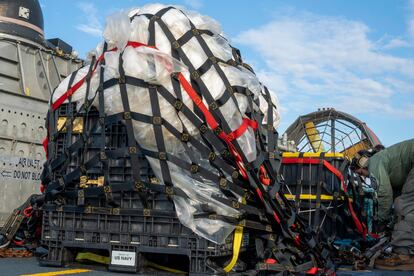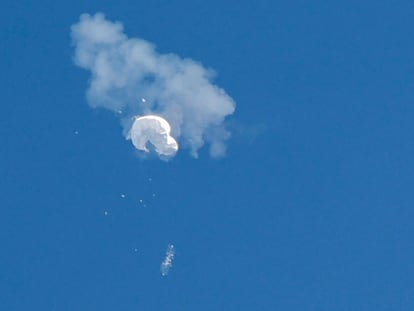US ends search for objects shot down over Alaska, Lake Huron
The announcements capped three dramatic weeks that saw US fighter jets shoot down four airborne objects

The US military said Friday that it has ended its search for airborne objects that were shot down near Deadhorse, Alaska, and over Lake Huron on February 10 and 12. The statement released late Friday came hours after officials said the US has finished efforts to recover the remnants of the large balloon that was shot down February 4 off the coast of South Carolina, and analysis of the debris so far reinforces conclusions that it was a Chinese spy balloon.
Officials said the US believes that Navy, Coast Guard and FBI personnel collected all of that balloon’s debris off the ocean floor, which included key equipment from the payload that could reveal what information it was able to monitor and collect. White House national security spokesman John Kirby said a significant amount of debris was recovered and it included “electronics and optics” from the payload. He declined to say what, if anything, the US has learned from the wreckage so far.
US Northern Command said in a statement that the recovery operations ended Thursday and the final pieces are on their way to the FBI lab in Virginia for analysis. It said air and maritime restrictions off South Carolina have been lifted.
Northern Command said later that the decision to end the search for the objects shot down over Alaska and Lake Huron came after the U.S. and Canada “conducted systematic searches of each area using a variety of capabilities, including airborne imagery and sensors, surface sensors and inspections, and subsurface scans, and did not locate debris.” Northern Command said air and maritime safety perimeters were also being lifted at both those sites.
The announcements capped three dramatic weeks that saw US fighter jets shoot down four airborne objects – the large Chinese balloon on February 4 and three much smaller objects about a week later over Canada, Alaska and Lake Huron. They are the first known peacetime shootdowns of unauthorized objects in US airspace.
While the military is confident the balloon shot down off South Carolina was a surveillance airship operated by China, the Biden administration has admitted that the three smaller objects were likely civilian-owned balloons that were targeted during the heightened response, after US homeland defense radars were recalibrated to detect slower moving airborne items.
Much of the Chinese balloon fell into about 50 feet (15 meters) of water, and the Navy was able to collect remnants floating on the surface, and divers and unmanned naval vessels pulled up the rest from the bottom of the ocean. Northern Command said Friday that all of the Navy and Coast Guard ships have left the area.
On Thursday, President Joe Biden directed national security adviser Jake Sullivan to lead an interagency team to establish “sharper rules” to track, monitor and potentially shoot down unknown aerial objects.
Meanwhile, key questions about the Chinese balloon remain unanswered, including what, if any, intelligence it was able to collect as it flew over sensitive military sites in the United States, and whether it was able to transmit anything back to China.
The US tracked it for several days after it left China, said a US official who spoke to The Associated Press on condition of anonymity to discuss sensitive intelligence. It appears to have been blown off its initial trajectory, which was toward the US territory of Guam, and ultimately flew over the continental US, the official said.
Balloons and other unidentified objects have been previously spotted over Guam, a strategic hub for the US Navy and Air Force in the western Pacific.
It’s unclear how much control China retained over the balloon once it veered from its original trajectory. A second US official said the balloon could have been externally maneuvered or directed to loiter over a specific target, but it’s unclear whether Chinese forces did so.
Sign up for our weekly newsletter to get more English-language news coverage from EL PAÍS USA Edition
Tu suscripción se está usando en otro dispositivo
¿Quieres añadir otro usuario a tu suscripción?
Si continúas leyendo en este dispositivo, no se podrá leer en el otro.
FlechaTu suscripción se está usando en otro dispositivo y solo puedes acceder a EL PAÍS desde un dispositivo a la vez.
Si quieres compartir tu cuenta, cambia tu suscripción a la modalidad Premium, así podrás añadir otro usuario. Cada uno accederá con su propia cuenta de email, lo que os permitirá personalizar vuestra experiencia en EL PAÍS.
¿Tienes una suscripción de empresa? Accede aquí para contratar más cuentas.
En el caso de no saber quién está usando tu cuenta, te recomendamos cambiar tu contraseña aquí.
Si decides continuar compartiendo tu cuenta, este mensaje se mostrará en tu dispositivo y en el de la otra persona que está usando tu cuenta de forma indefinida, afectando a tu experiencia de lectura. Puedes consultar aquí los términos y condiciones de la suscripción digital.










































